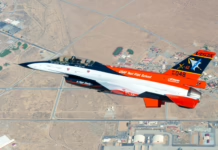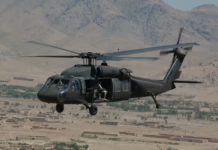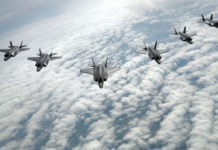The Italian aerospace company is advancing a major Block 20 upgrade while promoting the twin-engined jet as the common training platform for the multinational sixth-generation fighter program involving Italy, Japan and the UK.
Leonardo has positioned its M-346 advanced trainer aircraft as the ideal platform for preparing pilots to operate the future Global Combat Air Programme (GCAP) fighter jet, while simultaneously advancing work on a significant Block 20 upgrade for the in-service fleet.
“We should not develop GCAP without thinking about the training platform, and why not start with the M-346,” said Tommaso Pani, Leonardo Aircraft’s senior vice-president of marketing and strategic campaigns. “It is something that I believe we should do together with our GCAP partners at an industry level, with BAE [Systems] and Mitsubishi Heavy Industries.”
The GCAP initiative unites Italy, Japan, and the UK in developing a sixth-generation fighter aircraft scheduled to enter service from 2035. Leonardo sees a natural fit for its M-346 in this ecosystem, with the Italian air force already operating the aircraft and both Japanese and British student pilots currently training on the type at the International Flight Training School (IFTS) in Sardinia.
“I am confident that the M-346 is the right basis to start the development of the GCAP trainer,” Pani noted. “We are not talking about a new structure of the aircraft, but a new cockpit and avionics.”
Leonardo unveiled a prototype of its enhanced cockpit design at the Defence iQ Military Flight Training conference near Cagliari, Sardinia on March 31. The Block 20 upgrade program, officially launched at the Farnborough air show last July, will result in enhanced M-346 T Block 20 trainers and F-model light combat aircraft deliveries later this decade.
“The environment is changing rapidly,” Pani explained. “It is clear that there is a requirement for flight skills, but also for information management skills. It is time now to find a balance.”
The Block 20 upgrade features significant cockpit enhancements, including a Leonardo-developed large-area display (LAD) measuring 20 x 8 inches and a low-profile head-up display for both crew positions. The system can display up to four multi-function displays with configurable top and bottom information bars.
“The cockpit and large area display are working very well,” Pani said of the prototype, while acknowledging, “we are still developing and fine-tuning our system.”
Additional upgrades include an autothrottle, automatic ground collision avoidance system, datalink capability, and performance-based navigation to comply with civilian airspace requirements. Leonardo is employing an open systems architecture design to accommodate future adaptations.
The F-model variant will gain an active electronically scanned array (AESA) radar and capability to carry medium-range air-to-air missiles, expanding beyond the short-range weapons currently cleared for use. It will maintain its maximum 3,000kg (6,610lb) stores capacity across seven hardpoints and receive a comprehensive self-protection system including radar warning receivers, missile warning, and countermeasures.
Austria will be the launch customer for the Block 20 version, having selected the M-346 for a 12-aircraft light fighter requirement in December. “The discussions are ongoing within the government-to-government framework, and are very positive. We are very confident to be able to finalize an agreement in a short time,” Pani stated.
The development timeline shows a preliminary design review completed last year, with critical design review scheduled for the second half of 2024. The first Block 20 aircraft is expected to fly in mid-2027, with customer deliveries beginning in late 2028.
With 146 M-346 aircraft ordered to date and more than 100 already delivered, the platform has accumulated over 130,000 flight hours. Current operators include Greece, Israel, Poland, Qatar, Singapore, and Turkmenistan, with Nigeria set to receive its first aircraft soon from a 24-unit order.
Leonardo sees substantial growth opportunities for the M-346 platform. “There are at least 15 to 20 customers that are looking for a new trainer or fighter that can perform as a trainer,” Pani noted. Key prospects include Canada’s future fighter lead-in training requirement and the US Navy’s Undergraduate Jet Training System program to replace the Boeing T-45 Goshawk, where Leonardo has partnered with Textron Aviation Defense.
“The market for light fighter and training aircraft is huge, and it is increasing a lot rapidly in terms of requests,” Pani added, mentioning potential opportunities in Australia, Finland, Japan, and the UK.

Key Takeaways
- Leonardo is positioning its M-346 aircraft as the ideal training platform for the multinational Global Combat Air Programme fighter program scheduled for 2035 service entry.
- The Block 20 upgrade introduces advanced cockpit displays, safety systems, and enhanced combat capabilities, with Austria as the launch customer for a 12-aircraft order.
- With 146 M-346s ordered and over 130,000 flight hours accumulated, Leonardo sees growing market potential across 15-20 countries seeking advanced trainers or light fighters.








